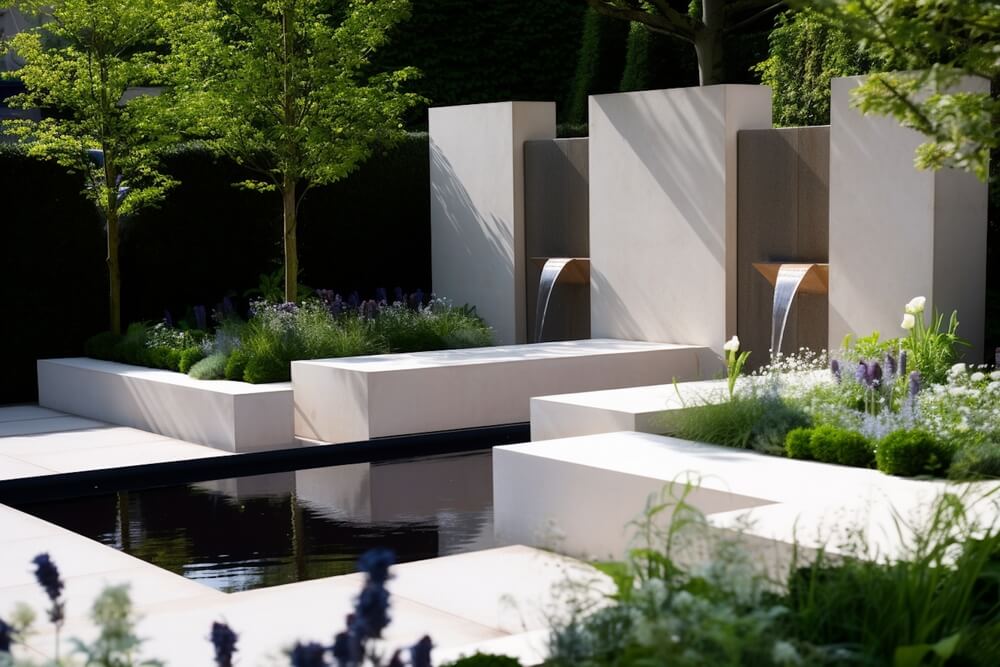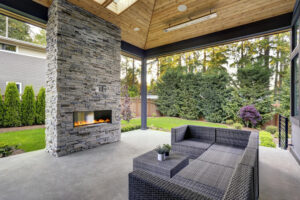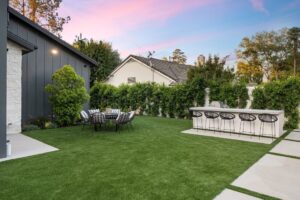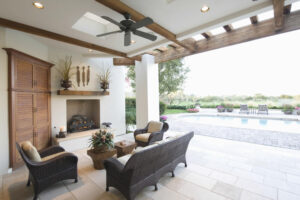Transforming your outdoor space into a serene oasis is no longer just a dream, thanks to the enchanting allure of water features. These captivating elements, from tranquil ponds to elegant fountains, bring a sense of calm and beauty to any landscape. For contractors and industry leaders in the roofing and remodeling space, incorporating water features into outdoor living projects not only enhances aesthetic appeal but also elevates the overall value and functionality of the space.
In this piece, Cricket Pavers dive into the art of integrating water features into your outdoor designs, offering a wealth of ideas and practical tips to ensure your projects stand out. With Leap as your trusted advisor, you’ll be equipped to create stunning outdoor environments that delight clients and set your work apart from the competition.
Selecting the Perfect Water Feature
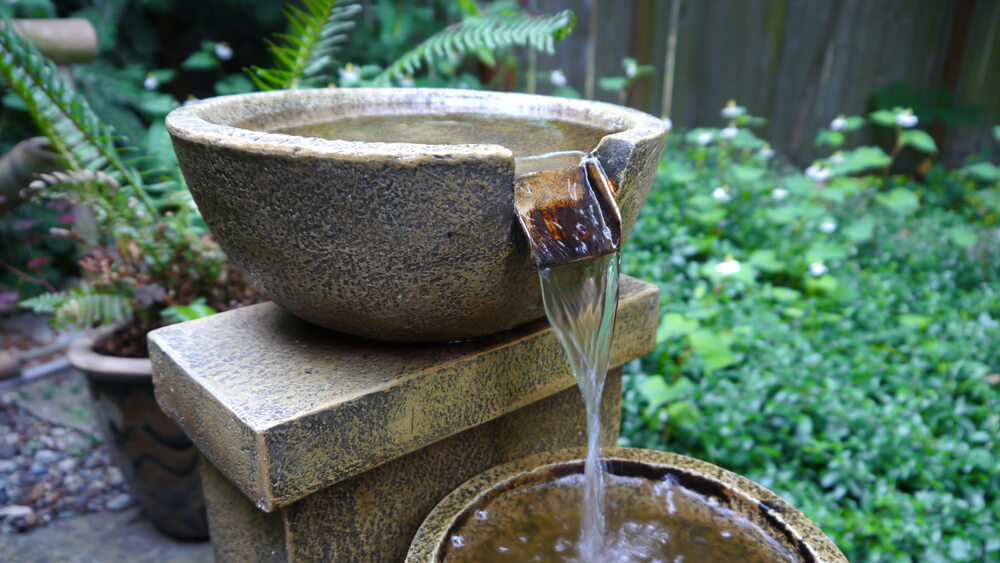
Explore Fountain Varieties
Fountains are a versatile choice for outdoor spaces, offering a range of styles to suit any design preference. Consider classic tiered fountains, perfect for creating a sense of elegance and tradition. For a more contemporary appeal, opt for sleek, minimalist fountains with clean lines and modern materials like stainless steel or glass. If space is limited, wall-mounted fountains offer a compact yet striking option. These can be easily installed on existing structures, providing a soothing waterfall effect. Bubbling rock fountains are another popular choice, blending seamlessly into natural landscapes with their rustic charm.
Each variety offers unique benefits, whether it’s the gentle trickling sound or the visual interest they add to your outdoor living area. As you select a fountain, think about how it complements the overall aesthetic of your space and the ambiance you want to create for clients.
Consider Ponds and Waterfalls
Ponds and waterfalls bring a dynamic element to any outdoor space, offering both visual and auditory appeal. Ponds can serve as a focal point, creating a peaceful retreat that attracts wildlife such as birds and butterflies. When designing a pond, consider incorporating native aquatic plants and fish to enhance the ecosystem and support local biodiversity. Waterfalls, on the other hand, add movement and the calming sound of flowing water, making them ideal for creating a spa-like atmosphere.
They can be integrated into rock formations or garden walls, blending seamlessly with natural surroundings. When selecting a pond or waterfall, think about the size and layout of your space to ensure the feature feels proportionate and harmonious. These water features not only enhance the aesthetic beauty of your outdoor living area but also provide a tranquil setting that can be enjoyed year-round.
Optimal Placement Strategies
Evaluate Viewing Angles
When incorporating water features into your outdoor space, considering the viewing angles is crucial for maximizing their impact. Start by identifying key vantage points, such as seating areas, patios, or windows, where the water feature will be most visible and appreciated. A well-placed fountain or pond can transform a simple garden view into a captivating scene, drawing the eye and inviting relaxation. Ensure that the water feature complements the overall landscape design and does not obstruct pathways or views.
Additionally, consider how natural light interacts with the feature throughout the day. Sunlight can enhance the sparkle of moving water, creating a stunning visual effect. For nighttime enjoyment, plan for strategic lighting to highlight the feature’s best angles. By thoughtfully evaluating the viewing angles, you can create a harmonious outdoor living space where the water feature becomes a central element that enhances the enjoyment and value of the environment.
Ensure Maintenance Accessibility
When planning the placement of water features, it’s essential to consider maintenance accessibility to ensure long-term functionality and aesthetics. Choose a location that allows easy access for routine tasks such as cleaning, inspecting pumps, and adjusting water levels. This consideration prevents future headaches, saving time and effort for both contractors and homeowners. If the water feature is near shrubs or trees, ensure there’s enough space to maneuver equipment without damaging surrounding plants.
Additionally, think about how seasonal changes, like leaf fall or freezing temperatures, might impact maintenance needs and access. Providing a clear path to the water feature and using modular designs that allow for easy disassembly can streamline upkeep. By prioritizing maintenance accessibility from the start, you empower clients with a water feature that remains a delightful focal point with minimal effort, enhancing the outdoor living space while maintaining its charm and functionality over time.
Achieving Size and Scale Balance
Harmonize with Garden Proportions
Creating a harmonious balance between your water feature and garden proportions is vital for an aesthetically pleasing outdoor space. Begin by assessing the scale of the garden and determining how the water feature will fit within the existing landscape. A small fountain can become a charming focal point in a compact garden, while a large pond might be more suitable for expansive areas. Avoid overwhelming the space with a feature that’s too large or underwhelming it with one that’s too small. To achieve balance, consider the height, width, and depth of the water feature in relation to surrounding elements like plants, paths, and structures.
Incorporating design elements such as rocks or plants can help integrate the feature naturally into the landscape. By aligning the size and scale of your water feature with garden proportions, you ensure a cohesive look that enhances the space’s natural beauty and invites relaxation.
Avoid Overwhelming Design
To maintain a balanced and inviting outdoor space, it’s crucial to avoid overwhelming design when incorporating water features. Overly intricate or large-scale features can dominate the landscape, detracting from the overall harmony of the garden. Begin by considering the existing design elements and choosing a water feature that complements rather than competes with them. Simplicity often yields the most elegant results, allowing the water feature to integrate seamlessly into the environment.
Pay attention to the materials and colors used; they should resonate with the natural surroundings and architectural style of the home. Additionally, consider the sensory impact—both visually and audibly. A softly bubbling fountain might be more suitable for a tranquil space than a loud, cascading waterfall. By avoiding overwhelming design choices, you ensure that the water feature enhances rather than overshadows the garden, contributing to a serene and balanced outdoor atmosphere that your clients will love.
Seamless Landscaping Integration
Use Native Flora
Incorporating native flora around your water feature is a strategic way to achieve seamless landscaping integration. Native plants are adapted to the local climate and soil conditions, making them easier to maintain and more resilient to pests and diseases. They also support local wildlife, attracting birds, butterflies, and beneficial insects, which adds life and movement to your outdoor space. When choosing plants, consider their growth habits and how they complement the water feature’s design.
Taller plants can provide a backdrop, while smaller groundcovers can soften edges and create a natural transition. Native flora can also enhance the seasonal interest of your garden, offering blooms, foliage, and textures that change throughout the year. By using native plants, you not only create a cohesive and environmentally friendly landscape but also reduce maintenance efforts, allowing the water feature to blend naturally into the surroundings and become a harmonious part of the ecosystem.
Incorporate Natural Elements
Integrating natural elements around your water feature is an effective way to enhance seamless landscaping integration. Elements like rocks, stones, and gravel can mimic the natural settings of streams and ponds, providing a cohesive look that aligns with the water feature’s aesthetic. These materials can be used to create borders, pathways, or even small rock gardens, adding texture and depth to the design. Additionally, consider incorporating driftwood or fallen branches to further blend the feature into the landscape.
These organic materials offer a rustic appeal and can serve as habitats for small wildlife. The goal is to create a space that feels as though it has always been part of the natural environment, achieving a tranquil and cohesive outdoor living area. By thoughtfully incorporating natural elements, you enhance the visual harmony and ecological balance of your garden, creating a serene oasis that clients can enjoy year-round.
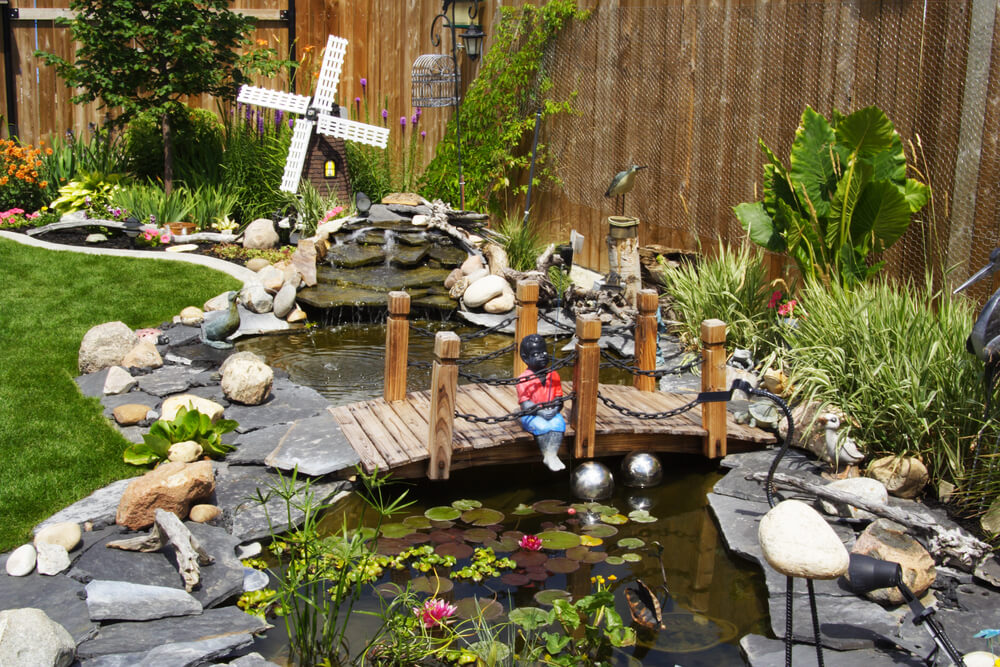
Enhancing with Lighting
Create Evening Ambiance
Creating an evening ambiance around your water feature involves strategic lighting that highlights its beauty and enhances the outdoor space’s atmosphere. Start by using underwater lights to illuminate the water from within, casting shimmering reflections and drawing attention to the movement and flow of the feature. Soft LED lights can be placed around the perimeter to outline the shape and create subtle highlights.
Consider using solar-powered lights for an eco-friendly option that enhances paths leading to the feature, ensuring safety while adding a warm glow. Additionally, incorporating lanterns or string lights in nearby trees or structures can add a magical touch, making the area inviting and cozy. The key is to achieve balance—ensure the lighting is not overpowering but instead complements and enhances the natural serenity of the water feature.
By carefully planning your lighting design, you create a captivating evening retreat that extends the enjoyment of your outdoor space well into the night.
Highlight Pathways
Highlighting pathways with strategic lighting is essential for both safety and aesthetics in your outdoor space. By illuminating paths, you guide guests safely through the garden, especially during evening hours, while also accentuating the landscape’s design elements. Begin with low-level path lights which can be installed at intervals to provide consistent illumination without overwhelming glare. Solar-powered options are energy-efficient and environmentally friendly, requiring minimal maintenance.
Consider using fixtures that complement the style of your garden, whether it’s modern, rustic, or traditional. For a more dramatic effect, integrate uplighting to accentuate trees or large plants bordering the pathway, creating intriguing shadows and depth. Step lights can be used on stairs or uneven surfaces to enhance visibility and safety.
By thoughtfully highlighting pathways, you not only ensure a safe passage but also enhance the overall ambiance, inviting exploration and enjoyment of the outdoor living space after dark.
Call Us!
Our team is here for you, so call us and ask us anything you might need!
